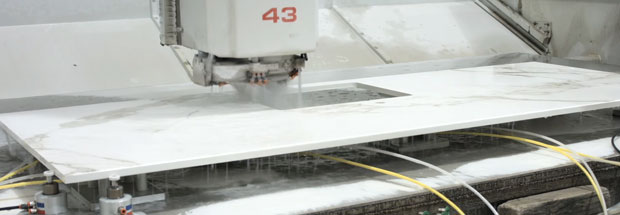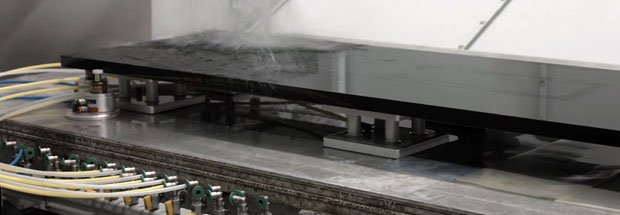Granite & quartz worktops – the basic differences
Most people are now familiar with granite & quartz as materials used in the production of kitchen worktops but the two are very different for a number of reasons.
Perhaps the most basic difference to start with is the composition of both: granite is a hundred per cent natural, formed from stone resulting from hot magma having cooled, whilst quartz worktops are man made from a composite of ground quartz and resins, and this is sometimes referred to as ‘engineered stone’. It is largely composed of natural stone but it has been processed and mixed with other materials.
Granite became popular as a major choice for kitchen worktops in the 1980s and has remained a very popular choice ever since then; prior to that it was used as a major building material for literally thousands of years, especially by the Egyptians who used it to build obelisks and columns, most notably those called Cleopatra’s Needles.
Sources of granite & quartz
Granite is formed from molten magma and is therefore found all over the world. It has to be mined from quarries and this is obviously a major operation. Countries such as India and Brazil where mining costs are much lower are major suppliers of granite as this helps to reduce production costs. A piece of granite will be literally many millions of years old.
Quartz worktops are made from a combination of ninety per cent ground quartz and added polymers, resins and pigments. Quartz is a natural hard mineral found in abundant quantities around the world.
The manufacturing process of granite & quartz
Quartz – An Italian company called Breton in Italy, were the first to produce machinery for manufacturing work surfaces formed from quartz and resins; they hold a number of patents for such machinery although other companies now produce similar equipment.
The Italian market dominated sales in the 1980s when quartz worktops began to be popular but now the growth of the Chinese economy has led to that country being a main supplier, producing the largest quantities. Many suppliers still use Breton machinery and processes.
Quartz is either bought by a manufacturer in rock form and then crushed to produce the necessary material, or already crushed stone material is bought.
The quartz is ground and it is the degree to which this is done that influences the appearance of quartz work surfaces. If the quartz is coarsely ground it will produce a flecked surface; if it is finely ground the surface will have a much smoother appearance.

Ground quartz is mixed with resin and different manufacturers use different types of resin, epoxy and polyester being the most common. In order to prevent fading from light ultra violet stabilisers are added together with stabilisers.
The mixture of quartz, resin and other chemicals is then formed into slabs by the manufacturing machinery; these slabs are then left to ‘cure’ or stabilise and this usually takes three to seven days; weather and other conditions can affect the length of time necessary for slabs to cure. When ready, the slabs are cut into the required sizes and thickness. The slabs are usually cut with a diamond blade or a water jet cutter.
Granite – Granite is mined from quarries that are in granite deposit sites. It is cut or blasted from deposits using explosives in huge chunks; these are then transported to processing factories and cut into slabs by a diamond or water jet cutter just as quartz slabs; they are then transported to a manufacturer where they are polished using further machinery and sometimes cut into smaller slabs. Modern day shipping techniques allow slabs to be transported anywhere across the world.
Suppliers of granite worktops will clearly need to further work the stone in order to make it fit a particular kitchen design and accommodate features such as sinks and taps. This work needs to be done by professional skilled craftsmen and a single feature can take several hours of work to accommodate.
See how our granite is made
Differences between granite & quartz worktops
As a natural stone, Granite is found in a variety of colours ranging from light to dark; as with any natural formation, it is subject to variations in colour and pattern; this makes all pieces unique but also means that when several pieces need to be joined, that it becomes a specialist job to try to match them and there can be small visible joining seams.
Granite is found in two different forms, Variegated and Consistent; Variegated granite will have been affected by movement during its formation and this results in patterns containing veins and swirls of differing colours to the main body of stone. Consistent granite bears the same pattern throughout the piece. The area from which the granite is sourced will affect the pattern and colour.
An advantage of granite is that it remains cool and so has advantages over quartz surfaces in that hot items can be placed onto it directly. Its ability to retain coolness also makes granite a good choice for those who want a cool surface on which to prepare ingredients, for example in baking.
Maintenance of granite worktops is relatively easy; they can be simply wiped over, providing that they have been treated with a sealant; this will need to be repeated throughout the life of a granite worktop and preferably on a yearly basis. Granite can be scratched, so careful use of utensils and chopping boards are advised to avoid damage from cutting is recommended. With regards to staining, granite is fairly resistant.
Quartz, or engineered stone worktops are not porous, as are those made of natural stone, e.g. granite and as a consequence are not as vulnerable to issues such as mildew and mould. They are also harder than some types of natural stone.
Because of the way quartz worktops are manufactured, they do not contain hidden cracks and faults the way that natural stone granite can do and they do have a degree of flexibility, which prevents them from cracking under pressure; however, as time continues to harden the material, this flexibility will decrease.
It is not necessary to seal quartz worktops at all as they are non porous and this also makes them very stain-resistant. This is an advantage over granite, which must be sealed and that sealant needs to be regularly renewed.
Despite the addition of UV filtering agents in the composition of quartz worktops, prolonged exposure to ultra violet light can cause deterioration in colour and even break down the resins that bond the whole material together. This means that quartz is not the best choice for areas that are going to be exposed to considerable natural light. Making seams less visible is easier with quartz than granite, especially with darker colours.
Unlike granite, quartz worktops can be damaged by the application of direct heat, but this would need to be at a temperature of 150 degrees Centigrade or above. Sudden temperature change, however, can also damage them and so manufacturers recommend the use of trivets to avoid hot pans or objects being placed directly on the surface.
Comparative costs of granite & quartz
Quartz worktops are manufactured and involve no mining or quarry work; the production costs are therefore often less than those of granite and quartz can therefore be less expensive. However, the costs of granite will vary considerably depending upon the quality of granite, the type and the availability of both; for example, some colours and patterns will only be available in granite from a particular area and availability will therefore certainly vary.
The design of any kitchen and even the type of kitchen sink will alter the costs of producing granite worktops as the cutting and polishing involved will increase according to designs. Any curves involved will involve more polishing and this will increase the price. Another factor that will influence costs is that most of both granite and quartz worktop materials will be sourced from abroad necessitating transportation; the costs of this are going to be influenced by the price of oil and transport fuel.
There seems to be a fall in the price of granite making it about the same or very close to the price of quartz; however, the practically zero maintenance nature of quartz compared to the need to ensure granite is regularly sealed, which in itself involves further regular costs, may make what is sometimes a slightly higher initial outlay better value in the long run.
At the end of the day, they are both great looking worktops and it’s down to you which one you like the look of, that is going to complement your kitchen the most.
Like granite? Why not have a look at the newest ultra compact Dekton solid surface worktops. Great features and great value!
Download our mobile app
Looking for some kitchen inspiration? Take a look at some of our real customer kitchens, video reviews as well as advice in our mobile app. We’ll also keep you up to date with any new ranges and offers that we have available.
Up to 50% off competitor kitchen prices
At DIY Kitchens, not only do you get a quality rigid built kitchen but you also get it at a fabulous price too! Price your kitchen up on our site and you could see savings of up to 50% off other kitchen quotes that you’ve had.
Take a look at our kitchen price comparison page here.
Real customer kitchens
Get some inspiration for designing your own new kitchen with over 3,000 pictures of our customers’ kitchens that they ordered from us.



What thicknesses do you solid surface worktops come in?
Hi Lee, our Granite worktop thickness is 30mm. Quartz is available in 30mm and 20mm depths and Dekton is available with a depth of 20mm.
Can I have a piece of quartz which is 3.4 long without a join? Also, if I had an L-shaped kitchen, can the entire L be 1 piece or would it be 2 and have to be joined?
Hi Heather, our granite supplier’s jumbo pieces of quartz are a maximum of 3.2m long. So any lengths longer than that would have to have a join. They can also supply the full L shape as one piece but depending on the size, this may have to be 2 lengths.
I want to order a Quartz worktop for my kitchen, do your fitters remove an old one to fit the new one?
Hi, when ordering the Quartz worktop you will need to make sure you have removed your original worktop for when we come out and template your kitchen.
I have original belfast basin, need work top with drainer…marble/light colour, what do you have please. cheers
Hi, we offer Granite and Quartz worktops in a variety of colours and styles, which can have a drainer grooved into them. All these are available to view online. I would recommend the Lyra Quartz as this quite a light/marble colour.